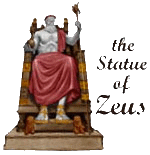The temple of Artemis at Ephesus
The Mausoleum at Halicarnassus
The Hanging Gardens of Babylon
Built: About 457 B.C.
Location: At the ancient town of Olympia, on the west coast of modern Greece, about 150 km west of Athens.
History: In about 450 B.C., the city of Olympia -- where the first Olympic Games were held in 776 B.C. -- built a temple to honor the god Zeus.
Many considered the Doric-style temple too simple, so a lavish 40-foot statue of Zeus was commissioned for inside. Athenian sculptor Phidias created an ivory Zeus seated on a throne, draped in a gold robe. Zeus had a wreath around his head and held a figure of his messenger Nike in his right hand, and a scepter in his left.
Eventually, wealthy Greeks decided to move the statue to a palace in Constantinople (present-day Istanbul, Turkey). Their effort prolonged its life, as fire later devastated the Olympia temple. However, the new location couldn't keep Zeus eternally safe: a severe fire destroyed the statue in 462 A.D.
All that remains in Olympia are the temple's fallen columns and the foundation of the building.
The ancient Greek calendar starts in 776 BC, for the Olympic games are believed to have started that year. The magnificent temple of Zeus was designed by the architect Libon and was built around 450 BC. Under the growing power of ancient Greece, the simple Doric-style temple seemed too mundane, and modifications were needed. The solution: A majestic statue. The Athenian sculptor Pheidias was assigned for the "sacred" task, reminiscent of Michelangelo's paintings at the Sistine Chapel.
For the years that followed, the temple attracted visitors and worshippers from all over the world. In the second century BC repairs were skillfully made to the aging statue. In the first century AD, the Roman emperor Caligula attempted to transport the statue to Rome.However, his attempt failed when the scaffolding built by Caligula's workmen collapsed. After the Olympic games were banned in AD 391 by the emperor Theodosius I as Pagan practices, the temple of Zeus was ordered closed.
Olympia was further struck by earthquakes, landslides and floods, and the temple was damaged by fire in the fifth century AD. Earlier, the statue had been transported by wealthy Greeks to a palace in Constantinople. There, it survived until it was destroyed by a severe fire in AD 462. Today nothing remains at the site of the old temple except rocks and debris, the foundation of the buildings, and fallen columns.

